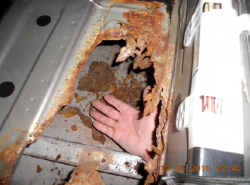
— A Nissan Altima rusted floor pan lawsuit alleges 2002-2006 Altimas have floorboards that rust from the inside out to the point occupants can see the road below them through the rusted holes.
The class-action lawsuit includes Missouri owners of 2002-2006 Altima cars with floor pans that don't drain water properly, which causes rust to completely destroy the floorboards, causing severe safety hazards to drivers and their passengers.
Plaintiff Laura Frances Hays says she purchased her 2003 Nissan Altima new in 2003 and always kept it in a garage at work and at home. In 2015 an inspection found rust under the front passenger floorboard (photo above), so she got an estimate for repairs from a body shop. Hays says she was told the job would cost at least $4,000 and possibly $5,000 by the time the work was complete.
The plaintiff says she received a second estimate from a different repair shop, but this time only for a "patch job" where the shop would cover the rusted floor pan with sheet metal. The patch repair estimate was for $459, so the plaintiff chose that repair and paid the $459.
After her Nissan dealer referred her to corporate, she submitted both repair estimates to Nissan but the automaker said it wouldn't pay anything for repairs. Hays says she decided to trade-in the Altima when it had 103,000 miles.
According to the lawsuit, the Altima floorboard has a concave design that allows moisture to accumulate and remain in the affected area.
The floor pan lawsuit names numerous problems that can arise because of the rusted pans.
A corroded floor pan can easily allow fire to enter the floor area when normally the area would have protection from the floorboard. For a car that enters water, such as a crash into a lake, occupants could quickly drown from water entering the holes in the floor pan, not to mention how the Altima would sink faster than it normally would.
Then there is the common hazard of exhaust fumes that owners complain about that enter the occupant areas through the rusted floor pan holes. The plaintiff also claims drivers and passengers are exposed to debris and other road objects entering the floorboard area of the Altima, as well as to accidently putting their feet and legs through the openings.
Nissan allegedly should have known about the rusted floorboard problem because of years of owner complaints going back to at least 2008, yet the automaker continued to install floorboards that rust away.
Nissan issued a technical service bulletin (TSB) for the Altimas for a floor pan repair because of rust and corrosion. The bulletin includes an example photograph which shows a floorboard with massive amounts of rust and a hole.
Along with the service bulletin, Nissan sent an Altima floor pan repair kit bulletin to its dealerships which talks about the “new, low-cost repair for floor pan corrosion.”
The TSB tells dealers to clean the rusted area of the floorboard and using adhesive, install a “repair plate” that covers the rusted area of the floorboard.
The bulletin does not instruct dealers to remove the rusted area of the floorboard. And according to the lawsuit, if a consumer has the repair plate installed, the Altima owner will need to pay about $500 toward the repair offered by the bulletin, even though the materials for the repair cost only $111.57.
Nissan allegedly designed the defective floorboards with a metal member attached directly on top of the concave section of the floorboard by welds that join only the perimeter of the member to the floorboard. The combination of this layered design and insufficiently patched holes in the metallic layers was a design defect that created the conditions for accelerated corrosion.
The member isolates this concave region of the floorboard from the carpeted foot well, reducing the likelihood that any accumulated moisture could be wicked away from the metal floor pan by the carpeting or any padding material. Instead, a small gap exists between the top of the floorboard and underside of the member on top.
Comparable vehicles from other manufacturers allegedly don't suffer the same problems because they do not share the defective design seen in the Altimas.
For example, 2002 Volkswagen Golfs have multiple layered floorboards that also have floor pan holes. But unlike the Nissan cars, these holes are sealed with plastic plugs that are mechanically attached with waterproof adhesive. This plug seals the floor pan hole from both the top and bottom, preventing moisture from entering and accumulating.
The plaintiff says Altimas manufactured outside of the affected model year ranges are designed differently and have not experienced the severe corrosion seen in the affected model years.
Because the replacement of the floorboard can cost several thousand dollars and because Nissan refuses to recognize the existence of a defect or to cover the full cost of repairs, many Altima owners are not in a position to replace the floor pans when they discover the problem.
Additionally, Nissan has provided no assurances that any replacement floorboard will not suffer from the same problems.
The Nissan Altima floor pan lawsuit was filed in the U.S. District Court for the Western District of Missouri - Laura Frances Hays, et. al., v. Nissan North America, Inc, et. al.
The plaintiff is represented by Williams Dirks Dameron LLC, Stueve Siegel Hanson LLP, and Dollar, Burns & Becker.
A similar Altima lawsuit was filed in Illinois a few years ago, but the automaker won dismissal of the case.
Read complaints about floor pan rust in the Nissan Altima cars named in the lawsuit:




